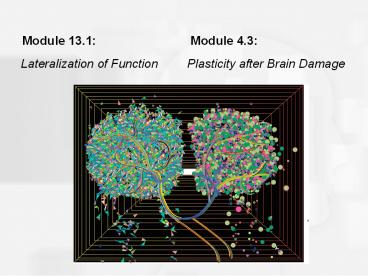Module 13.1: - PowerPoint PPT Presentation
Title:
Module 13.1:
Description:
Title: PowerPoint Presentation Author: Owner Last modified by: Abby A. Delman Created Date: 8/22/2005 7:57:47 PM Document presentation format: On-screen Show (4:3) – PowerPoint PPT presentation
Number of Views:99
Avg rating:3.0/5.0
Title: Module 13.1:
1
- Module 13.1
- Module 4.3
- Plasticity after Brain Damage
- Lateralization of Function
2
The Left and Right Hemispheres
- Commissure, a set of axons that connects the
hemispheres - Corpus callosum
- Anterior commissure
- Hippocampal commissure
3
Lateralization Division of labor between the two
hemispheres
4
Visual Field What is visible at any momentLeft
and right visual fields Each processed in
contralateral hemisphereOptic chiasm where
crossover of info occurs
Visual Connections to the Hemispheres
5
Auditory Connections Each hemisphere gets
information, but contralateral hemisphere pays
more attention
Auditory Connections to the Hemispheres
6
Cutting the Corpus Callosum
- Epilepsy
- A condition involving excessive, synchronized
neural activity - Seizure Behavioral symptom, can range from mild
to severe - Focus Point in brain where seizure begins
- Commissurotomy Severing of the corpus callosum
- Split-brain patient has undergone a
commissurotomy
- Severed Corpus Callosum video clip (10m)
- https//www.youtube.com/watch?vlfGwsAdS9Dc
7
Functions Associated with the Hemispheres
8
Development of Lateralization and Handedness
- Maturation of the corpus callosum
- Planum temporale
- Critical for speech comprehension
- Larger in left temporal lobe of 65 of people
- Occurs gradually over time
- Young children have more difficulty coordinating
limbs
9
Plasticity After Brain Damage
- Survivors of brain damage show subtle to
significant behavioral recovery. - Video clip from The Secret Life of the Brain,
The Aging Brain (2002) - https//www.youtube.com/watch?veoC4PgFsF84
10
Plasticity After Brain Damage
- Possible causes of brain damage include
- tumors
- infections
- exposure to toxic substances
- (a) Brain of a person who died immediately after
a stroke. Note the swelling on the right side.
(b) Brain of a person who survived for a long
time after a stroke. Note the cavities on the
left side, where many cells were lost. (c) Brain
of a person who suffered a gunshot wound and died
immediately.
- degenerative diseases
- closed head injuries
- stroke
11
Plasticity After Brain Damage
- Stroke (cerebrovascular accident, CVA)
- temporary loss of blood flow to the brain
- common cause of brain damage in the elderly
- Types of strokes include
- Ischemia -most common type of stroke
- Hemorrhage -less frequent type of stroke
12
Plasticity After Brain Damage
- Ischemia and hemorrhage also cause
- Edema-the accumulation of fluid in the brain
- increases pressure on the brain
- increases the probability of further strokes
- kills neurons
13
Treatments after Stroke
- Tissue plasminogen activator (tPA) breaks up
blood clots and reduces the effects of ischemic
strokes. - Cooling brain (91-97F)
- less activity
- lower energy needs
- less risk of overstimulation
- Cannabinoids
- minimize cell loss after brain damage by
decreasing the release of glutamate. - Excess glutamate may result in the
over-excitation of neurons
14
Plasticity After Brain Damage
- Diaschisis refers to the decreased activity of
surviving neurons after damage to other neurons.
15
Plasticity After Brain Damage
- Damaged axons do grow back under certain
circumstances. - PNS axon grows back at a rate of about 1 mm per
day.
16
Plasticity After Brain Damage
- Collateral sprouts are new branches formed by
other non-damaged axons that attach to vacant
receptors.
17
Plasticity After Brain Damage
- Denervation supersensitivity- the heightened
sensitivity to a neurotransmitter after the
destruction of an incoming axon and usually a
result of increased receptors.
18
Plasticity After Brain Damage
- Phantom limb refers to the continuation of
sensation of an amputated body part and reflects
this process. - The cortex reorganizes itself after the
amputation of a body part by becoming responsive
to other parts of the body.
19
Plasticity After Brain Damage
- Phantom limb can lead to the feeling of
sensations in the amputated part of the body when
other parts of the body are stimulated.
20
Plasticity After Brain Damage
- Deafferenated limbs are limbs that have lost
their afferent sensory input.































